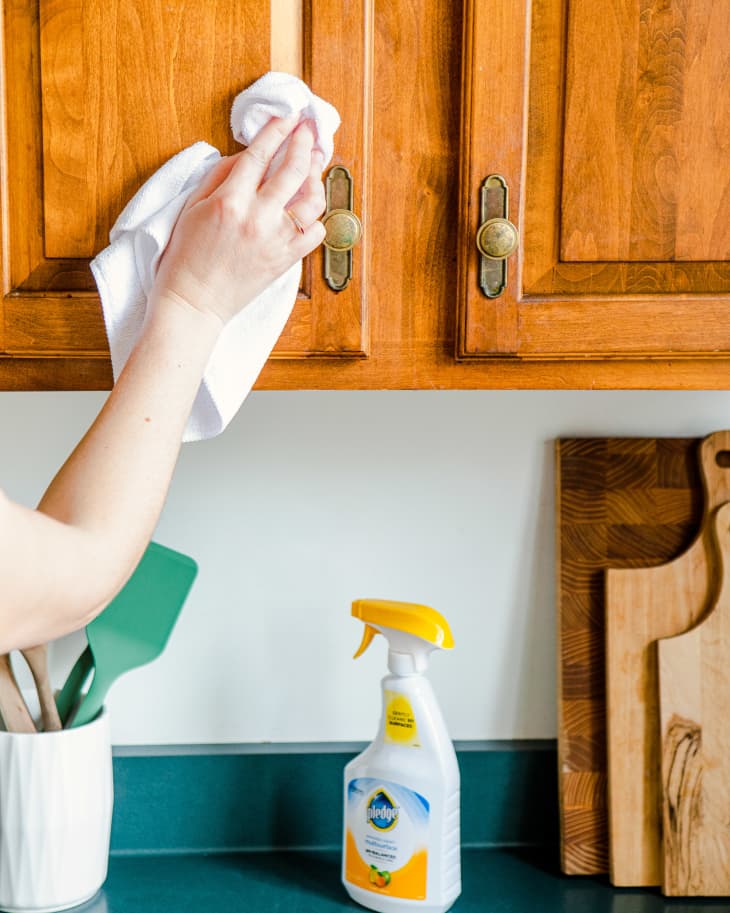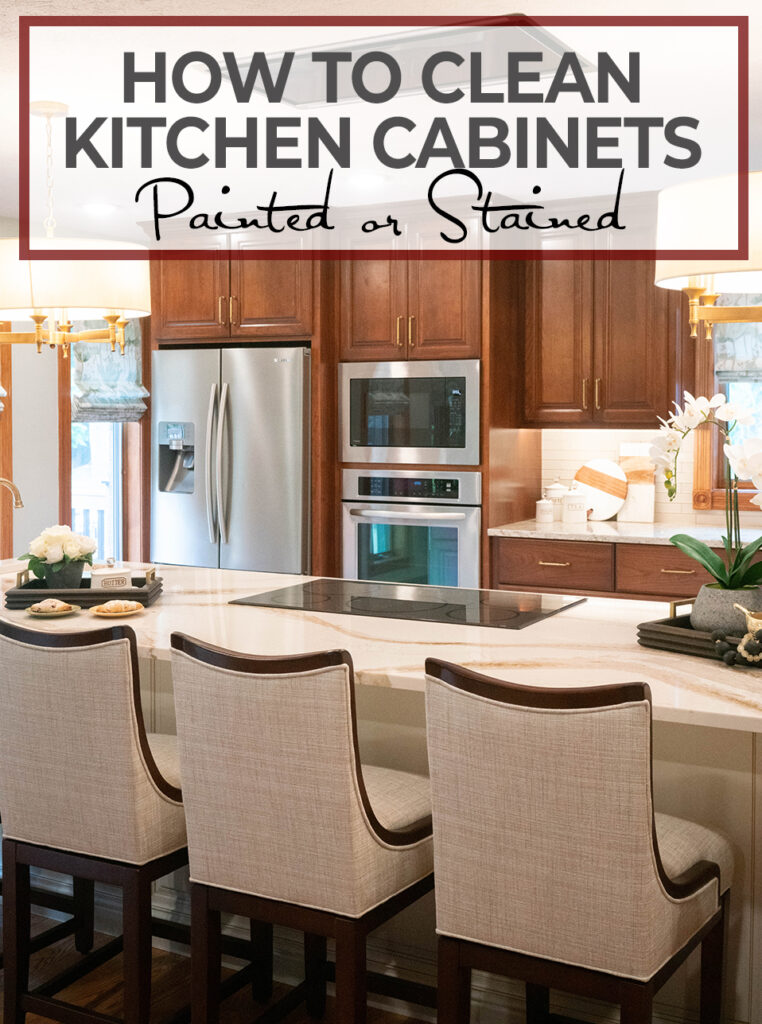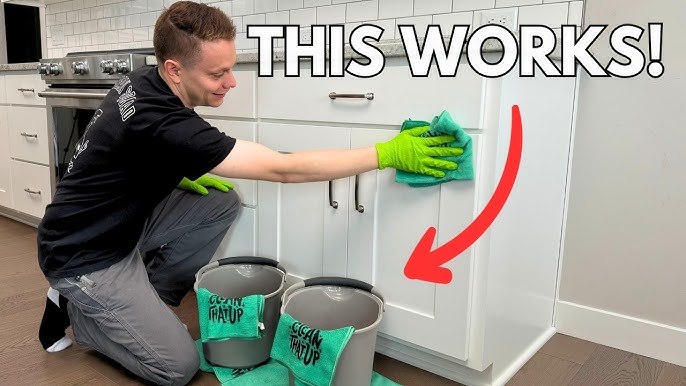Are your kitchen cabinets looking a little dull or sticky? It’s amazing how much grime and grease can build up over time.
You might be wondering, “What is the best cleaning solution for kitchen cabinets? ” You’re not alone. Many people find themselves in this exact situation, unsure of which product will bring back that original shine without damaging the finish. Imagine walking into your kitchen and seeing cabinets that look brand new.
Picture how satisfying it would feel knowing they’re not just clean but sanitized too. We’ll uncover the ultimate cleaning solutions that can transform your kitchen cabinets from grimy to gleaming. You’ll discover tips and tricks that could save you time and effort, and even a few DIY options that could spare your wallet. Stay with us, and let’s bring back that sparkle to your kitchen!
:max_bytes(150000):strip_icc()/how-to-clean-wood-kitchen-cabinets-0123-2000-641e7e2dcbdc4518a80417c66e2e9194.jpg)
Credit: www.marthastewart.com
Factors To Consider
Choosing the best cleaning solution for kitchen cabinets can seem daunting. Various factors influence your choice, and understanding these can save you time and effort. Let’s explore what you should consider to make your cabinets sparkle without damaging them.
Cabinet Material
The material of your kitchen cabinets dictates which cleaning solution will work best. Wooden cabinets require gentle care to avoid stripping the finish. Use a mild soap diluted in water. Test a small area first to ensure the solution doesn’t cause discoloration.
If your cabinets are laminate or metal, you can opt for stronger cleaners. However, avoid abrasives that could scratch the surface. What kind of cabinets do you have? Knowing this will guide your cleaning strategy.
Type Of Stains
Identifying the type of stains is crucial. Grease stains need a degreaser, while water stains might require a vinegar solution. For sticky residues, try baking soda mixed with water. Are you dealing with stubborn stains? Sometimes, a bit of elbow grease is the best solution.
Consider the frequency of spills and splashes in your kitchen. Frequent cooks may face different challenges than occasional ones. Tailor your cleaning arsenal to tackle your specific stain types effectively.
Eco-friendliness
Many cleaning solutions contain harsh chemicals harmful to the environment. Opting for eco-friendly products ensures you’re cleaning responsibly. Look for solutions with natural ingredients like lemon or vinegar. These are effective and safe.
Do you care about reducing your carbon footprint? Making small changes, like choosing green cleaning products, can have a big impact. Plus, they often smell better and are safer for your family.
Balancing efficiency and environmental care can sometimes be tricky, but it’s worth the effort. After all, what’s more important than a clean home that respects the planet?

Credit: www.thekitchn.com
Natural Cleaners
Natural cleaners offer a safe and effective way to clean kitchen cabinets. They don’t contain harsh chemicals, making them gentle on surfaces. Plus, they are environmentally friendly. Using natural ingredients can help maintain the beauty of your cabinets. Let’s explore some popular natural cleaning solutions.
Vinegar And Water
Vinegar is a powerful natural cleaner. It cuts through grease and grime effortlessly. Mix equal parts vinegar and water in a spray bottle. Spray the solution on your cabinets and wipe with a soft cloth. Vinegar’s acidity helps remove stubborn stains. It leaves surfaces looking fresh and clean.
Baking Soda Paste
Baking soda is a versatile cleaner. It acts as a gentle abrasive, perfect for tough spots. Combine baking soda with water to create a paste. Apply the paste to stained areas on your cabinets. Let it sit for a few minutes. Then, scrub gently with a sponge. Baking soda effectively removes stains without scratching.
Commercial Cleaners
Finding the right cleaning solution for kitchen cabinets ensures lasting shine and cleanliness. Mild dish soap mixed with warm water works wonders for most surfaces. For tougher stains, a vinegar and water mix can help remove grime without damaging the finish.
Avoid abrasive cleaners to keep cabinets looking new.
Cleaning your kitchen cabinets can be a rewarding experience, but choosing the right commercial cleaner can make all the difference. Commercial cleaners offer a convenient and powerful way to keep your cabinets looking fresh and new. They come in various formulations to suit different materials and cleaning needs. But with so many options available, how do you know which one is right for your cabinets?All-purpose Solutions
All-purpose cleaners are like the Swiss Army knife of cleaning products. They are designed to tackle a range of surfaces, making them perfect for mixed-material kitchen cabinets. If your cabinets are a blend of wood, metal, and laminate, an all-purpose cleaner can simplify your cleaning routine. Some popular brands include Lysol, Simple Green, and Mrs. Meyer’s. These cleaners are known for their versatility and effectiveness. Just spray, wipe, and enjoy the sparkle! However, be mindful of the ingredients. Ensure they are safe for all the materials in your kitchen to avoid any damage.Wood-specific Products
Wood cabinets have a unique charm, but they require special care. Wood-specific cleaners are formulated to protect and nourish the wood while cleaning it. These products often contain oils or waxes that enhance the natural grain and sheen. Brands like Murphy Oil Soap and Method Wood for Good are favorites among homeowners. They offer cleaning solutions that are gentle yet effective. They can bring out the beauty in your wood cabinets without stripping away their finish. Have you ever tried a wood-specific cleaner and marveled at how it revived the luster of your kitchen cabinets? It’s like giving them a spa day! While these cleaners are fantastic for wood, they might not be suitable for other materials. Always check the compatibility before applying them to avoid mishaps. Choosing the right cleaner can transform your kitchen and make your cabinets look as good as new. What will you choose for your cleaning arsenal?Diy Cleaning Solutions
DIY cleaning solutions offer a cost-effective and natural way to keep your kitchen cabinets sparkling clean. Many commercial cleaners contain harsh chemicals that can damage cabinet finishes over time. With DIY options, you can choose safe ingredients that are likely already in your pantry.
Imagine opening your cabinets and being greeted by the fresh scent of lemons or your favorite essential oils. Isn’t that inviting? Let’s dive into some easy and effective DIY cleaning solutions for your kitchen cabinets.
Lemon Juice Mixtures
Lemon juice is a fantastic natural cleaner due to its acidic nature. Mix equal parts of lemon juice and water in a spray bottle. Spray the solution on your cabinets and wipe with a soft cloth.
This mixture helps to cut through grease and grime without leaving a sticky residue. The fresh lemon scent lingers, leaving your kitchen smelling delightful. Have you tried using lemon juice for cleaning before?
For tougher stains, add a pinch of baking soda to the lemon juice mixture. The slight abrasiveness of baking soda enhances the cleaning power without scratching surfaces. Just ensure to rinse thoroughly with water afterward.
Essential Oil Blends
Essential oils not only smell great but also have natural antibacterial properties. Combine a few drops of tea tree or lavender oil with water and white vinegar for a potent cleaning blend. This solution can effectively clean and sanitize your cabinets.
Add a touch of your preferred essential oil to give your kitchen a personalized scent. Orange oil works well for a refreshing aroma, while eucalyptus offers a calming effect. Why not experiment with different combinations to find your signature kitchen scent?
It’s interesting how essential oils can elevate the cleaning process to a therapeutic experience. Just ensure that you shake the mixture well before each use, as oils can separate from water. Are you ready to make cleaning a more enjoyable task?
With these DIY solutions, cleaning your kitchen cabinets can be both effective and enjoyable. You might even find yourself looking forward to it! What are your favorite DIY cleaning tips?
Application Techniques
Keeping your kitchen cabinets clean not only enhances the aesthetics of your kitchen but also extends the lifespan of the cabinets. The effectiveness of cleaning often lies in the application techniques you choose. How do you apply your cleaning solution to ensure a spotless finish without damaging the surface? Let’s dive into some practical methods that can make a significant difference.
Soft Cloth Usage
Using a soft cloth is one of the gentlest ways to clean your cabinets. Opt for microfiber cloths, as they are designed to lift dirt without scratching surfaces. Start by dampening the cloth slightly with your chosen cleaning solution. Avoid soaking it completely to prevent water damage to the wood.
Wipe in gentle, circular motions. This prevents streaking and ensures an even clean. You might find that this technique requires a bit more patience, but the results are worth it. Have you ever noticed how a simple wipe can transform the appearance of your cabinets?
Spray Bottle Methods
Spray bottles offer convenience and control. Fill a spray bottle with your cleaning solution and lightly mist the surface of the cabinets. Be careful not to overspray, as excess liquid can seep into the wood and cause swelling or warping.
Once sprayed, use a cloth or sponge to wipe down the cabinets. This method works exceptionally well for reaching corners and crevices. Consider this: have you ever used a spray bottle to clean and found it easier to target specific areas?
Both methods have their merits and can be adapted based on your cabinet material and personal preference. What technique resonates most with you? Share your experiences and tips below!

Credit: gmi.design
Safety Precautions
Cleaning kitchen cabinets requires careful attention to safety precautions. Certain cleaning solutions can be harsh. They may pose risks if not handled properly. Using these solutions safely is crucial. Ensure your cleaning routine is both effective and safe.
Ventilation Needs
Proper ventilation is essential during cleaning. Many solutions have strong fumes. Open windows and doors to allow air flow. This reduces inhalation risks. Use fans to increase air circulation. Protect your health with fresh air.
Protective Gear
Wearing protective gear is important. Use gloves to shield your skin. Some solutions can irritate. Eye protection is also recommended. Goggles prevent accidental splashes. Safety glasses can be a good alternative. Ensure you’re fully covered before you start.
Maintenance Tips
Maintaining the shine and functionality of your kitchen cabinets doesn’t have to be daunting. With a few simple tips, your cabinets can remain the centerpiece of your kitchen, looking fresh and new for years. Let’s dive into some practical maintenance strategies that can make a significant difference.
Regular Cleaning Schedule
Imagine walking into your kitchen and feeling proud of the sparkling cabinets that greet you. Establishing a regular cleaning schedule is key to achieving this. Consider cleaning your cabinets at least once a week. A quick wipe down with a damp cloth can prevent dust and grime buildup. It’s a small task that pays off in the long run, preserving the beauty of your kitchen.
Consistency is crucial. Mark your calendar or set a reminder on your phone. This ensures you never miss your cleaning routine, turning it into a pleasant ritual rather than a chore. Have you ever noticed how a clean kitchen cabinet can uplift your mood?
Avoiding Harsh Chemicals
Using harsh chemicals might seem like a quick fix for stubborn stains, but they can damage your cabinets over time. Opt for gentle cleaners instead. For instance, a mixture of vinegar and water can effectively clean without harming the finish. It’s a simple solution that you can whip up with ingredients you probably already have.
Consider the surface of your cabinets. Are they wood, laminate, or painted? Each material responds differently to cleaning agents. It’s essential to choose a cleaner that matches your cabinet type to avoid any unwanted reactions. What’s your go-to cleaning solution?
Remember, maintaining kitchen cabinets is about balancing effort with results. With these tips, you can keep your cabinets looking their best without breaking a sweat or the bank.
Frequently Asked Questions
What Is The Safest Cleaner For Kitchen Cabinets?
The safest cleaner for kitchen cabinets is a mild dish soap solution. Mix a few drops in warm water. Use a soft cloth to wipe down surfaces. This method avoids harsh chemicals, ensuring your cabinets stay undamaged and clean. It’s ideal for regular maintenance and keeps cabinets looking new.
How Often Should I Clean Kitchen Cabinets?
Cleaning kitchen cabinets should be done every two weeks. Regular cleaning prevents grease and grime buildup. Focus on handles and edges where dirt accumulates. Thoroughly clean every few months for deeper maintenance. This routine keeps your cabinets hygienic and looking their best.
Can Vinegar Be Used On Kitchen Cabinets?
Yes, vinegar can be used on kitchen cabinets. Mix equal parts vinegar and water for a natural cleaning solution. It’s effective in removing grease and stains. However, avoid using on cabinets with finishes that might react negatively to acidity. Always test a small area first.
What Removes Sticky Residue From Cabinets?
To remove sticky residue, use a baking soda paste. Mix baking soda with water to form a thick paste. Apply to the sticky area and scrub gently. Rinse with a damp cloth. Baking soda’s mild abrasiveness helps lift residue without damaging the cabinet surface.
Conclusion
Choosing the right cleaning solution matters for kitchen cabinets. It helps keep them fresh and gleaming. Consider natural options like vinegar or baking soda. They clean effectively without harsh chemicals. Regular maintenance keeps cabinets in good shape. Avoid abrasive scrubbers to prevent scratches.
Test products on a small area first. This ensures safety for all surfaces. Remember, a clean cabinet boosts kitchen appeal. Use gentle methods for lasting results. Happy cleaning for a welcoming kitchen space!

As the chief content writer, Hassan Al Sarker works as a professional kitchen-based content creator at Kitchen Liker.
In addition to reviewing the content published on Kitchen Liker, he ensures that it is accurate, relevant, and helpful. As a result, all the reviews and information published at Kitchen Liker are neutral and userfriendly.
Hassan Al Sarker has a bachelor’s degree in Hotel and Tourism Management From the Newyork University. Before joining Kitchen Liker, he was a contributor at Kitchen Club, United States.

